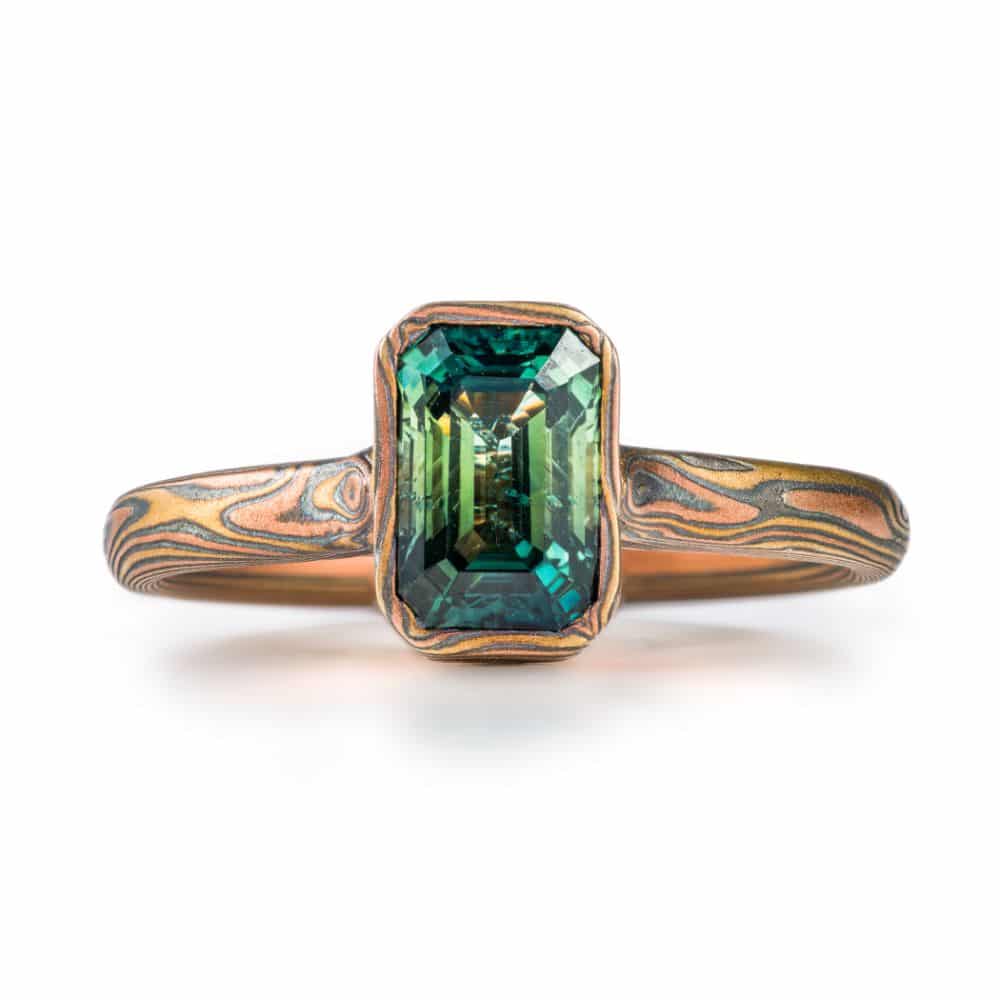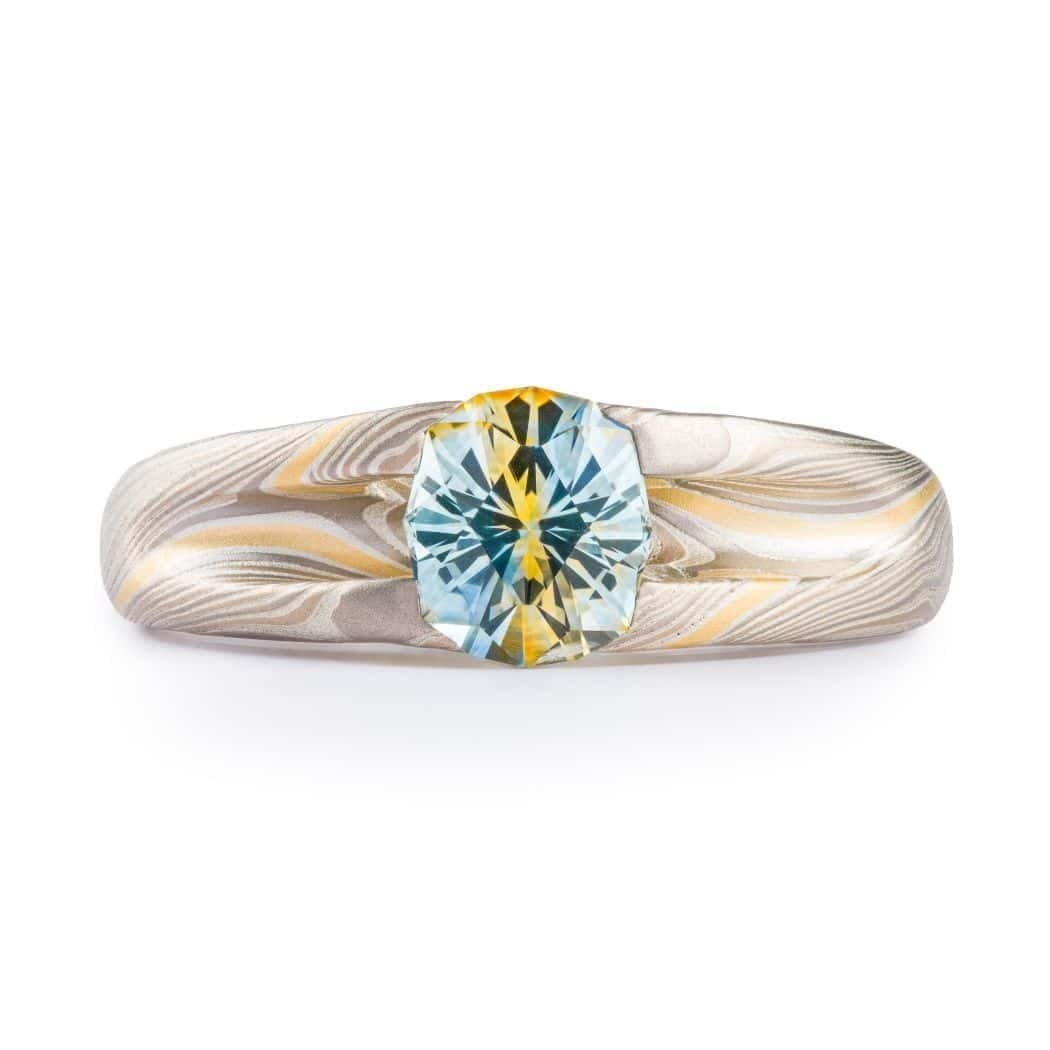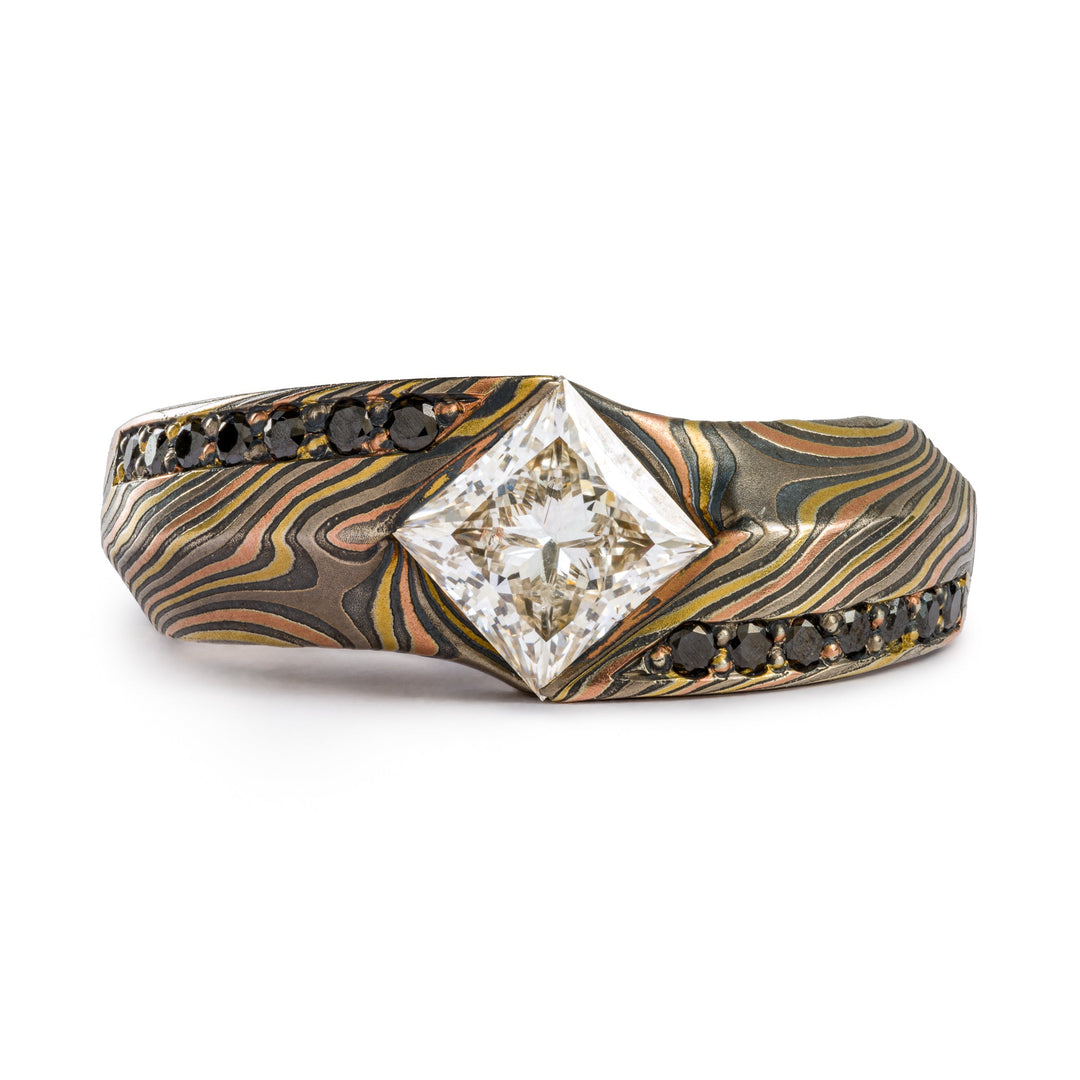Our Blog
A log of our process, on the web.
Chisel Patterning Mokume Gane Class at Metalwerx
Posted by on
Chisel Patterned Mokume Gane Class at Metalwerx
Read more
Chisel Patterning Mokume Gane Class at Metalwerx
Posted by Arn Krebs on
Princess Cut, Brilliant Cut, Emerald Cut, Marquis...Exploring the Art of Stone Cuts
Posted by Arn Krebs on

Including set stones in your design is a great way to elevate and customize your ring even further as an object de art. Arn sources incredible sapphires, diamonds, and moissanites from trusted sources and skilled lapidaries. He works with these stones specifically because they are the hardest and most durable stones, and they come in a range of beautiful colors. Arn works with each stones’ unique aspects to integrate it with your mokume gane rings’ composition, pattern and palette.
Cuts like the round brilliant or cushion can enhance the ring's organic patterns, while angular cuts like the princess or emerald may contrast for a striking effect. This interplay of elements creates a balanced and visually appealing composition.
Stones can be cut in so many ways, each style with different aspects. Understanding the interaction between light and a gemstone is very helpful in appreciating cuts. When light enters a stone, it reflects off its internal surfaces, creating a dazzling play and range of colors known as 'fire.' A well-cut stone will guide light optimally, increasing its brilliance and fire.
Selecting the right stone cut for a mokume ring involves considering how the cut complements the ring's design. The right stone cut transforms a gemstone, capturing light and color in its facets. Each cut unlocks the stone's potential, revealing its hidden beauty and brilliance.
At its core, a stone's cut refers to the geometric arrangement of its facets. These facets are strategically placed to reflect and refract light, enhancing the stone's inherent qualities.
Facets are the flat surfaces on a gemstone, and when facets are perfectly aligned, they create a kaleidoscope of colors, bringing the stone to life. The art of facet arrangement is both a science and an art, requiring skill and precision.
Cut, color, clarity, and carat weight are the universal standards for assessing diamond quality. While all are important, cut is often considered the most influential. A well-cut stone will outshine one with better color or clarity but a poor cut.
The overall shape of the stone is an important factor to consider as well. Different shapes each interact with light in unique ways, each offering distinct visual effects. The choice of shape can also affect the stone's perceived size; for example, elongated cuts like marquise or oval can make a stone appear larger than its actual carat weight.
The Classic Round Brilliant

The round brilliant cut is the most popular choice for diamonds, renowned for its ability to maximize light return through its facets.
This cut has a rich history, evolving from early diamond cuts that sought to maximize carat retention rather than brilliance. Its modern form was perfected in the 20th century with the advent of precise mathematical calculations and cutting techniques.
The design involves precise angles and facet placements to enhance light performance. The interplay of these facets allows light to be refracted and reflected multiple times, creating the signature sparkle that defines this cut.
The Brilliant cut has become a classic choice for engagement rings, visually pleasing to the eye, and generally appealing, allowing it to adapt to suit a range of different styles. Its more traditional look contrasts with the more modern and unconventional look of mokume gane, which can make for a beautifully interesting engagement ring.
The Princess

For those seeking a more angular look, the Princess cut can be the perfect choice, with its square shape, pointed corners and crisp, angular facets.
The princess cut was developed in the late 20th century, quickly gaining popularity as a more modern style. Its name evokes a sense of royalty and sophistication, appealing to those who love a blend of traditional and contemporary. The cut's sharp angles and clean lines offer a fresh take on classic elegance.
The princess cut’s design maximizes the stone's inherent sparkle and can make inclusions less visible than in other cuts. This combination of brilliance and practicality of cost contributes to its widespread appeal.
The princess cut's modern silhouette makes it versatile for various jewelry styles, from minimalist solitaire settings to elaborate multi-stone arrangements. And the straight lines of the princess cut can play well with various different mokume patterns. Contrasting against the organic and flowing style of a carved pattern like wood grain or twist, or complementing a forged pattern like vortex that has a more linear style.
The Emerald

Characterized by its rectangular shape and step-cut facets, the emerald cut emphasizes clarity and elegance. The emerald cut has a long history, originally developed for cutting emeralds to reduce pressure during the cutting process and prevent fractures. Its distinctive step-cut facets were later applied to diamonds, offering a unique alternative to more common brilliant cuts.
This cut's step-cut facets create a 'hall of mirrors' effect, and its elongated shape can make a stone appear larger, while the open facets provide a clear view into the stone's interior. The emerald cut is often associated with vintage and Art Deco styles, exuding sophistication and timeless beauty. Its refined appearance suits those who value classic elegance and understated glamour.
The Marquise

The Marquise cut is characterized by its elongated shape, pointed on both ends, creating an iconic and unique silhouette. The marquise cut's origins trace back to the 18th century, commissioned by King Louis XV of France, who desired a diamond cut that mirrored the smile of his mistress, the Marquise de Pompadour.
The marquise cut's elongated shape creates the illusion of greater size, making it a popular choice for maximizing carat weight. Its distinctive shape is ideal for those seeking a bold and elegant statement piece.
This cut is perfect for more eclectic and creative tastes, with its pairing of elegant curves and sharp points. It’s a striking and dramatic choice paired with mokume gane, making for beautiful engagement rings.
The Cushion

With its rounded corners and larger facets, the cushion cut exudes a romantic aura. It's particularly well-suited for colored gemstones like sapphires. The cushion cut, also known as the 'pillow cut,' has been a popular choice since the 19th century. It was the top choice for diamonds before the advent of the modern brilliant cut. Its soft, rounded edges and antique charm have ensured its enduring popularity among vintage jewelry enthusiasts.
The cushion cut especially enhances color and clarity, making it a great choice for colored stones. This is a cut anyone interested in a colored stone should consider. We love pairing beautifully colored sapphires and diamonds with mokume gane which is inherently a color based material.
The Asscher

Revered for its Art Deco appeal, the Asscher cut features a square shape with deep step cuts, similar to the emerald cut but with more angular precision. This cut is known for its dramatic optical effects and timeless elegance. The Asscher cut was developed in 1902 by the Asscher Brothers of Amsterdam, renowned diamond cutters of their time. Its unique design and angular precision quickly gained popularity during the Art Deco era.
The Asscher cut is also known for its distinctive deep cut, creating an intensely sparkling effect. It is a wonderful choice for those looking for a dramatic statement stone.
The Rose

This cut is characterized by a domed face with triangular facets, and a flat back. It’s often associated with vintage style jewelry pieces, as it was most popular in the mid 1700s and about 1840-1900. The Rose cut became less common with the invention of the modern version of the Brilliant cut in 1900, though it had a resurgence in the 1920’s and 30’s with the Art Deco movement. Art Deco jewelry favored large gemstones, and the Rose cut lends well towards this style, as it maximizes carat weight, letting smaller carat stones appear bigger.
The Rose cut is most often seen as a circle or oval, but is available in so many more shapes! Some Rose cut stones have a more opaque appearance, and the shallowness of the stones creates more of a subtle glimmer, rather than a dramatic sparkle. This cut is a perfect choice to suit a more classic or vintage leaning style, and offers a lot of character. It’s the perfect choice to create an heirloom mokume piece with a nod to the past.
Selecting the Right Cut for Your Jewelry
Choosing the right cut for your jewelry is a personal decision, influenced by style, symbolism, the type of gemstone, and the intended use of the piece.
In addition to style and symbolism, practical factors such as durability, daily use, and maintenance should be considered when selecting a cut. Some cuts, like the marquise or pear, may require protective settings to prevent damage to pointed tips. People who work with their hands and are very active might prefer a classic round stone to one that has square or pointed edges perhaps. Understanding these considerations ensures that the engagement ring remains a beautiful and enduring symbol of love.
Read more
Princess Cut, Brilliant Cut, Emerald Cut, Marquis...Exploring the Art of Stone Cuts
Posted by Susan Freda on

Including set stones in your design is a great way to elevate and customize your ring even further as an object de art. Arn sources incredible sapphires, diamonds, and moissanites from trusted sources and skilled lapidaries. He works with these stones specifically because they are the hardest and most durable stones, and they come in a range of beautiful colors. Arn works with each stones’ unique aspects to integrate it with your mokume gane rings’ composition, pattern and palette.
Cuts like the round brilliant or cushion can enhance the ring's organic patterns, while angular cuts like the princess or emerald may contrast for a striking effect. This interplay of elements creates a balanced and visually appealing composition.
Stones can be cut in so many ways, each style with different aspects. Understanding the interaction between light and a gemstone is very helpful in appreciating cuts. When light enters a stone, it reflects off its internal surfaces, creating a dazzling play and range of colors known as 'fire.' A well-cut stone will guide light optimally, increasing its brilliance and fire.
Selecting the right stone cut for a mokume ring involves considering how the cut complements the ring's design. The right stone cut transforms a gemstone, capturing light and color in its facets. Each cut unlocks the stone's potential, revealing its hidden beauty and brilliance.
At its core, a stone's cut refers to the geometric arrangement of its facets. These facets are strategically placed to reflect and refract light, enhancing the stone's inherent qualities.
Facets are the flat surfaces on a gemstone, and when facets are perfectly aligned, they create a kaleidoscope of colors, bringing the stone to life. The art of facet arrangement is both a science and an art, requiring skill and precision.
Cut, color, clarity, and carat weight are the universal standards for assessing diamond quality. While all are important, cut is often considered the most influential. A well-cut stone will outshine one with better color or clarity but a poor cut.
The overall shape of the stone is an important factor to consider as well. Different shapes each interact with light in unique ways, each offering distinct visual effects. The choice of shape can also affect the stone's perceived size; for example, elongated cuts like marquise or oval can make a stone appear larger than its actual carat weight.
The Classic Round Brilliant

The round brilliant cut is the most popular choice for diamonds, renowned for its ability to maximize light return through its facets.
This cut has a rich history, evolving from early diamond cuts that sought to maximize carat retention rather than brilliance. Its modern form was perfected in the 20th century with the advent of precise mathematical calculations and cutting techniques.
The design involves precise angles and facet placements to enhance light performance. The interplay of these facets allows light to be refracted and reflected multiple times, creating the signature sparkle that defines this cut.
The Brilliant cut has become a classic choice for engagement rings, visually pleasing to the eye, and generally appealing, allowing it to adapt to suit a range of different styles. Its more traditional look contrasts with the more modern and unconventional look of mokume gane, which can make for a beautifully interesting engagement ring.
The Princess

For those seeking a more angular look, the Princess cut can be the perfect choice, with its square shape, pointed corners and crisp, angular facets.
The princess cut was developed in the late 20th century, quickly gaining popularity as a more modern style. Its name evokes a sense of royalty and sophistication, appealing to those who love a blend of traditional and contemporary. The cut's sharp angles and clean lines offer a fresh take on classic elegance.
The princess cut’s design maximizes the stone's inherent sparkle and can make inclusions less visible than in other cuts. This combination of brilliance and practicality of cost contributes to its widespread appeal.
The princess cut's modern silhouette makes it versatile for various jewelry styles, from minimalist solitaire settings to elaborate multi-stone arrangements. And the straight lines of the princess cut can play well with various different mokume patterns. Contrasting against the organic and flowing style of a carved pattern like wood grain or twist, or complementing a forged pattern like vortex that has a more linear style.
The Emerald

Characterized by its rectangular shape and step-cut facets, the emerald cut emphasizes clarity and elegance. The emerald cut has a long history, originally developed for cutting emeralds to reduce pressure during the cutting process and prevent fractures. Its distinctive step-cut facets were later applied to diamonds, offering a unique alternative to more common brilliant cuts.
This cut's step-cut facets create a 'hall of mirrors' effect, and its elongated shape can make a stone appear larger, while the open facets provide a clear view into the stone's interior. The emerald cut is often associated with vintage and Art Deco styles, exuding sophistication and timeless beauty. Its refined appearance suits those who value classic elegance and understated glamour.
The Marquise

The Marquise cut is characterized by its elongated shape, pointed on both ends, creating an iconic and unique silhouette. The marquise cut's origins trace back to the 18th century, commissioned by King Louis XV of France, who desired a diamond cut that mirrored the smile of his mistress, the Marquise de Pompadour.
The marquise cut's elongated shape creates the illusion of greater size, making it a popular choice for maximizing carat weight. Its distinctive shape is ideal for those seeking a bold and elegant statement piece.
This cut is perfect for more eclectic and creative tastes, with its pairing of elegant curves and sharp points. It’s a striking and dramatic choice paired with mokume gane, making for beautiful engagement rings.
The Cushion

With its rounded corners and larger facets, the cushion cut exudes a romantic aura. It's particularly well-suited for colored gemstones like sapphires. The cushion cut, also known as the 'pillow cut,' has been a popular choice since the 19th century. It was the top choice for diamonds before the advent of the modern brilliant cut. Its soft, rounded edges and antique charm have ensured its enduring popularity among vintage jewelry enthusiasts.
The cushion cut especially enhances color and clarity, making it a great choice for colored stones. This is a cut anyone interested in a colored stone should consider. We love pairing beautifully colored sapphires and diamonds with mokume gane which is inherently a color based material.
The Asscher

Revered for its Art Deco appeal, the Asscher cut features a square shape with deep step cuts, similar to the emerald cut but with more angular precision. This cut is known for its dramatic optical effects and timeless elegance. The Asscher cut was developed in 1902 by the Asscher Brothers of Amsterdam, renowned diamond cutters of their time. Its unique design and angular precision quickly gained popularity during the Art Deco era.
The Asscher cut is also known for its distinctive deep cut, creating an intensely sparkling effect. It is a wonderful choice for those looking for a dramatic statement stone.
The Rose

This cut is characterized by a domed face with triangular facets, and a flat back. It’s often associated with vintage style jewelry pieces, as it was most popular in the mid 1700s and about 1840-1900. The Rose cut became less common with the invention of the modern version of the Brilliant cut in 1900, though it had a resurgence in the 1920’s and 30’s with the Art Deco movement. Art Deco jewelry favored large gemstones, and the Rose cut lends well towards this style, as it maximizes carat weight, letting smaller carat stones appear bigger.
The Rose cut is most often seen as a circle or oval, but is available in so many more shapes! Some Rose cut stones have a more opaque appearance, and the shallowness of the stones creates more of a subtle glimmer, rather than a dramatic sparkle. This cut is a perfect choice to suit a more classic or vintage leaning style, and offers a lot of character. It’s the perfect choice to create an heirloom mokume piece with a nod to the past.
Selecting the Right Cut for Your Jewelry
Choosing the right cut for your jewelry is a personal decision, influenced by style, symbolism, the type of gemstone, and the intended use of the piece.
In addition to style and symbolism, practical factors such as durability, daily use, and maintenance should be considered when selecting a cut. Some cuts, like the marquise or pear, may require protective settings to prevent damage to pointed tips. People who work with their hands and are very active might prefer a classic round stone to one that has square or pointed edges perhaps. Understanding these considerations ensures that the engagement ring remains a beautiful and enduring symbol of love.
Read more
Susan Freda - Commissions & Designers
Posted by Susan Freda on

Susan Freda Art and Designers
Read more
Susan Freda - Commissions & Designers
Posted by Susan Freda on
Arn's Latest Metal Patterning in Mokume/
Posted by Susan Freda on
When we think of a "traditional" engagement/wedding style, the prong setting easily comes to mind. While this is indeed a classic look, there are some downsides to a prong setting. One thing to keep in mind is that they tend to be higher profile and more vulnerable, making it more likely to get snagged or bumped. Prongs can also weaken over time, and usually require re-tipping to keep a stone secure. Considering this, we'd like to show you a few more hardy and unique (but still elegant) bezel setting styles that can be made to last just like the mokume itself!
A great option for larger and uniquely shaped stones is a bezel setting! Here we have a few different takes on that style that complement the aesthetic of the mokume while also providing protection and support for these stones.
This is a partial mokume bezel, it can also be done as a full bezel, surrounding the stone on all sides. It is created from a piece of mokume stock just like the main ring, and helps the setting feel like an extension of the band with the continuation of mokume patterning!



Read more
Arn's Latest Metal Patterning in Mokume/
Posted by Susan Freda on
When we think of a "traditional" engagement/wedding style, the prong setting easily comes to mind. While this is indeed a classic look, there are some downsides to a prong setting. One thing to keep in mind is that they tend to be higher profile and more vulnerable, making it more likely to get snagged or bumped. Prongs can also weaken over time, and usually require re-tipping to keep a stone secure. Considering this, we'd like to show you a few more hardy and unique (but still elegant) bezel setting styles that can be made to last just like the mokume itself!
A great option for larger and uniquely shaped stones is a bezel setting! Here we have a few different takes on that style that complement the aesthetic of the mokume while also providing protection and support for these stones.
This is a partial mokume bezel, it can also be done as a full bezel, surrounding the stone on all sides. It is created from a piece of mokume stock just like the main ring, and helps the setting feel like an extension of the band with the continuation of mokume patterning!



Read more
A Healing Garden
Posted by Susan Freda on

Read more
A Healing Garden
Posted by Susan Freda on


